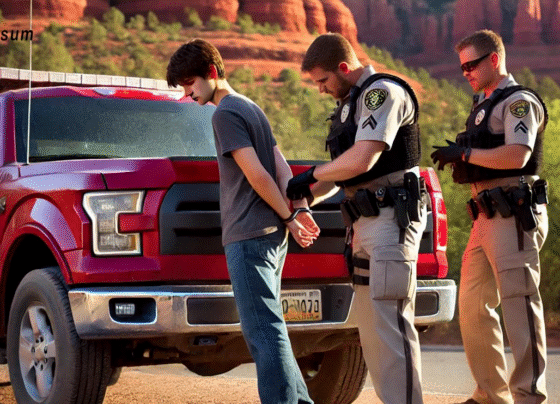By Steve Segner
Sedona AZ — On Wednesday night, August 13, I attended a Sedona City Council work session where the police department presented its Automated License Plate Reader (ALPR) program. The cameras had already been installed but were not yet activated. This project has been years in the making. City police staff began studying and evaluating the program in 2021, investing hundreds of hours to ensure it was approached with care and deliberation. Since then, the effort has carried through two city councils, two police chiefs, and two city managers—evidence of a thoughtful, methodical process aimed at getting it right before moving forward.

At the conclusion of the meeting, the majority of the City Council decided to pause activation until the city and police department could return with a more detailed proposal and review, addressing specific concerns. That follow-up is expected within the next 30–60 days.
It’s important to understand: this effort was never done in secret. It followed the normal process of the police department pursuing an improvement already in place in many cities across America. Funding was approved openly through the city’s budget process. If some members of the current council are only now realizing the scope of the project, that speaks more to the inherent complexity of city government than to any failure of transparency.
The issue only gained wide public attention after our local newspaper ran a headline declaring, “Sedona to residents: We’re tracking you.” That framing implied the police department intended to monitor residents’ daily movements. Unsurprisingly, it triggered a flurry of emails, social media posts, and public commentary claiming that “Big Brother” had arrived in Sedona. But nothing could be further from the truth.
Public Concerns vs. Demonstrated Facts
Roughly 30 residents were in attendance and 10 spoke against the program, arguing that ALPRs represent government overreach and a threat to personal liberty. Despite detailed presentations from both the vendor and Sedona Police Department explaining what the system does—and what it does not do—many remained unconvinced. Their objections seemed rooted more in distrust of government than in factual evidence.
This is hardly a new pattern for Sedona. Our community has loudly opposed cell towers, roundabouts, RF electric meters, and even conspiracy theories about non-existent chemtrails. ALPRs are simply the latest target in a long tradition of resistance. I understand, even the first traffic light at the Y, or the widening of 89A, was a fight to the death issue in town.
For now, the council has asked the city manager to form a work group and return with recommendations. This delays the decision but does not resolve the matter. Realistically, no matter what safeguards are proposed, the same critics will likely return with the same objections.
Purpose of ALPR in Sedona
The Sedona Police Department’s mission is straightforward: protect the community, safeguard children, and respond effectively to crime. ALPRs are designed to help with that mission. They are not surveillance tools for tracking ordinary residents.
Sedona does not exist in isolation. Criminals pass through town just as tourists do, and law enforcement needs the same tools available to departments nationwide.
ALPR technology has been around for decades. First developed in 1976, the system gained wider adoption in the 1990s and 2000s as police agencies recognized its effectiveness in recovering stolen vehicles and generating leads for investigations. Today, tens of thousands of cameras scan billions of plates monthly across the United States.
National law enforcement bodies—including the International Association of Chiefs of Police (IACP) and the Major Cities Chiefs Association—endorse ALPRs as valuable tools, provided they are governed by clear policies and strong oversight. Their position is simple: ALPRs can enhance public safety without sacrificing civil liberties.
Privacy Protections Under Federal Law
Privacy concerns are understandable, but ALPRs are already governed by federal law. The Driver’s Privacy Protection Act (DPPA), passed in 1994, restricts access to Department of Motor Vehicles records. Since ALPRs only capture license plate numbers, police must query DMV databases to connect a plate to a registered owner. That process is tightly regulated by DPPA, which permits such use only for legitimate law enforcement purposes.
The real issue is not whether plates can be scanned—they can, and have been for decades—but how long the resulting data is retained and how it is used. Most communities across Arizona and the country already employ ALPRs, most with clear retention limits. Sedona, in fact, is something of an outlier in even debating its legitimacy.
Benefits of ALPRs
The value of ALPRs lies in their practical uses:
- Child Safety: Alerting officers instantly when a vehicle involved in an AMBER Alert, enters Sedona.
- Crime Response: Identifying stolen vehicles and suspects linked to burglaries, violent crimes, or theft.
- Regional Coordination: Sharing real-time data with surrounding agencies, because criminals don’t respect city boundaries.
The success stories are well-documented:
- In New Mexico (2024), ALPRs helped rescue five kidnapped children.
- In Calera, Alabama (2023), a kidnapped child was found within hours.
- In Aspen, Colorado (2025), police located a missing child even after the suspect switched vehicles.
- In Flagstaff, Arizona (2025), ALPR technology identified a suspect in a fatal hit-and-run.
Safeguards to Protect Civil Rights
If implemented in Sedona, the ALPR system would come with strong safeguards, including:
- Short Data Retention: Non-hit data deleted after 30 days.
- Strict Use Limits: Restricted to AMBER and Silver Alerts, serious crimes, and “Be On the Lookout”
- No Facial Recognition: Only license plates and vehicle descriptions are recorded.
- Audit & Oversight: Every search logged, quarterly reviews conducted, and annual transparency reports issued.
- High Security: Data encrypted, with access strictly limited to authorized personnel.
- Accountability: The city council retains authority to suspend or terminate use if necessary.
The Real Choice Before Sedona
Sedona welcomes an average of 20,000 visitors each day. With that constant flow of people, inevitably, crime will occasionally follow. Automated License Plate Readers (ALPRs) give our officers a modern, proven tool to protect both residents and visitors.
This is not about “tracking everyone.” It is about identifying the one vehicle, the one suspect, or the one situation that poses a real threat before harm is done. By adopting ALPRs with clear safeguards, Sedona can strengthen community safety while preserving civil liberties. That balance is not only possible—it is already the accepted standard in cities across America.
When the Police Department brings this issue back before the City Council, the debate should be driven by facts, not fear. The overheated claims that ALPRs signal the arrival of Big Brother are exaggerated, emotional, and divorced from reality. Sedona’s residents—and the tens of thousands who visit daily—deserve decisions rooted in reason, not paranoia.
The loudest voices in the room will likely be the usual chorus of anti-government skeptics who see every policy as a conspiracy and every tool as a threat. Their cynicism does not equal wisdom. The real wisdom lies in building policy around evidence, safeguards, and proven results. If Sedona wants to protect its people without surrendering its values, the choice is clear: move forward with ALPRs and reject the fearmongering that does nothing to keep this community safe.
Sidebar:
In recent years, coverage in our local newspapers has blurred the line between fact and opinion, with news articles carrying headlines like “Sedona’s outrageously high pay-to-play development fees dooms workers” or labeling new police technology as “spy cameras.” These are not editorials but front-page reporting, and their tone is unmistakably designed to provoke. By framing complex policy decisions in terms of doom and betrayal, the papers risk inflaming outrage instead of informing public understanding. While such language may move papers off the rack or generate clicks online, it does little to help residents make sense of issues that require clarity, nuance, and balance.
Here is a link to the actual presentation of the police department to the city Council the other night. This includes 100 additional pages reflecting the city’s study of this topic since 2021. If you want to be informed, read this. https://www.sedonaaz.gov/home/showpublisheddocument/54696/638900064830560594
Here is a link to a map of the United States showing where thousands of these license plate readers are installed by one company. This demonstrates how Sedona is joining many others in using modern tools to protect its citizens and improve safety: https://deflock.me/map#map=12/34.860024/-111.798864







17 Comments
Steve,
I’m all for law enforcement having every tool available in their toolbox within reason. It’s great that the city and FLOCK had detailed explanations on how they readers work or don’t. What they need to do is better explain the safeguards that prevent misuse and abuse by the operator(s) and go over what checks and balances exist and what the penalties are if anyone is caught misusing the system. Until these things are laid out to the public the public will continue to distrust the motives and purpose behind it being installed in Sedona.
And lastly they need to ensure transparency by providing routine monthly and or annual reporting to the public on their daily use and findings. Members of the community should be able to submit FOIA requests for any and all non classified reporting of their individual license plate information.
Tools are great to have unless they are misused or abused! And the way to prevent misuse and abuse is 100% accountability and routine auditing of the system and its operators.
We all know how verbal assurances vs written contracts go. I remember being assured by King Trump that he knew absolutely nothing about Project 2025! And yet here we are 3/4 of the way into fully implementing every written word of one of the biggest coups in government ever! I want written rules, regulations and laws pertaining to how this plate analysis system will be regulated by its parent company and our City Government. There must be full accountability if this is to ever happen. No slaps on the wrists or “we didn’t know so we can’t be held accountable” bullshit like our government does with Social Media giants such as META and X who have both basically gotten away with inciting violence, promoting propaganda and lies, teen bullying and suicide and much more as we all watched the sham Congressional hearings into them where nobody was held accountable, nothing changed and half hearted apologies from criminals who are some of the wealthiest people in the world. Who made their money off of their crimes and from their clientele which they hold absolutely no legal obligation in safeguarding and protecting their clients and their clients information. Enough with the wealthy having absolute immunity and authority! Time to demand ACCOUNTABILITY!
The point I was making is the red rock news printed an editorial on the front page it was incorrect. I’ve just laid out the facts. The City Council has asked for more input, but I think it’s a good program. I think it shouldn’t just be killed because of fear of larger government. It’s a shame we don’t have a better reporting mechanism in town. Kyle on the red rock News actually came to the city meeting. That’s the first I remember in almost 20 years but I could be wrong.
Thank God the local newspaper brought this to light and we’re not the Orwellian, “1984” Communist Police State that could have happened.
Shame on Steve Sengor for wanting to have faceless bureocrats track our every move.
I also believe Law Enforcement should have the tools they need to do their jobs effectively and safely. Not a lot of difference between a patrol watching you driving down the road and a camera system doing their jobs effectively same thing only the cameras can cover what patrols cannot. What matters as Mr JB and others have shared is to have stringent oversight and auditing along with stiff penalties for those found abusing their position and the system. Any private surveillance system such as Ring or Blink can be accessed by law enforcement by simply making requests through their parent company. Until recently they didn’t even have to make a request and had fee and open access to our private security. What changed is legislation and regulation of those companies and how data can be accessed. Good or Bad any form of electronic surveillance should have the strictest oversight and regulation possible. No government at any level should be permitted to install such a system without having safeguards and legislation to protect non law violators from being tracked or surveilled without legal probable cause. Random surveillance of any and all vehicles to scan for law violations seems a bit like entrapment to me. No different than a cop staking out a bar awaiting people to drive away knowing the probability of a DUI/DWI arrest would be highly probable despite being a highly illegal arrest.
Much to mull over to be certain!
As usual, Steve has stated a very clouded & contrary view of the license readers.
Trust he is not busy constructing vulgar hand made signage to be displayed on Hwy 89A on this issue as he has on several prior Sedona issues.
Its Time, once again to cancel Steve & his sad beliefs.
Your cellphone and car track your every movement. So having cameras checking to see if your vehicle is legal is not much different. It’s what is done with that information that matters the most. We’re incapable of putting the technology genie back into it’s bottle unless somehow the entire planet has a zero day attack upon everything electrical.
It’s come to my attention that in the sidebar of my story/editorial, I did refer to a Red Rock News editorial, calling it a news story. I made a mistake. It was an editorial. I stand corrected, but I do not change my opinion that the local newspapers will not hesitate to use language in a headline and in the article itself that ignores long-held journalistic standards.
A bi-weekly small-town newspaper is no place for tabloid journalism. One would expect in-depth coverage with questions to the appropriate leaders of our community, like the police chief or city manager, to comment on the matter being brought up, instead of reverting to creating more headlines to shock people into believing the worst or buying the paper.
The following are examples of headlines that were published in Sedona Red Rock News
June 20, 2025 — “Sedona to residents: We’re tracking you.” (Human Interest) Confrontational phrasing frames surveillance before the reader is presented with the facts.
Oct. 14, 2024 — “Sedona’s microtransit system serves up $128 rides.” (City News) “Serves up” plus a shock number primes negativity.
Mar. 3, 2025 — “Microtransit ridership down, per-ride cost drops below $100.” (City News) Continues the money-first framing of “waste.”
Jun. 27, 2023 — “Sedona Shuttle likely releasing more emissions than cars.” (City News) Strong causal claim in a headline presented as fact.
Feb. 14, 2024 — “Planning and Zoning Commission approves homeless car camp.” (City News) Chooses stigmatizing shorthand (“homeless car camp”) rather than the program’s official name.
May 29, 2025 — “Residents may get to vote on Sedona Cultural Park fate.” (City News) “Fate” adds drama to a routine process story.
Mar. 18, 2024 — “Residents collecting signatures to force Cultural Park referendum.” (City News) “Force” frames citizen petitioning as coercive.
Nov. 25, 2022 — “Sedona acquires 41 acres plus $10M in debt with Cultural Park purchase.” (City News) Leads with “debt” to prime skepticism.
These are news articles, where readers expect neutral reporting. Phrasing like “tracking you,” “serves up $128 rides,” “force referendum,” “fate,” or “silent” primes emotion or judgment before the lede. That’s where the blurring of fact and opinion occurs.
I am told that in journalism education—such as at the University of Missouri, Columbia, or the Cronkite School at ASU—students are taught a fundamental rule: news and opinion must be kept separate. Neutral wording, headline restraint, and careful attribution are essential. The Associated Press Stylebook warns explicitly against loaded adjectives (outrageous, spy, threat, silent) in straight reporting.
Longstanding national newspapers (The New York Times, Washington Post, Wall Street Journal) enforce strict divisions between the news desk and the editorial board.
We may be a small town, but shouldn’t we expect the same high standard? We all have opinions. Let us decide what our opinion on any subject is. Only the editorials should be trying to influence us.
The Red Rock News editor could argue this is watchdog journalism: using bold words to ensure city leaders are held accountable and that residents’ frustrations aren’t ignored. That’s a legitimate defense. But the debate is whether watch-dogging requires the tools of opinion in pages presented as news.
You are totally right Mr. Segner about RRN’s journalistic principles. I don’t think they screw up on purpose but rather they think they are above it all meanwhile thier articles are replete with ill-disguised prejudice. Sedona.biz aren’t that much better but at least they don’t try to present themslves as the pillar of fair news reporting.
Ms Sarah
and why exactly is that? Because what you consider to be fair news reporting is the pillar of faith simply because it projects your opinion and feelings while excluding those opinions and feelings of others? That’s what Fox (Successfully sued for billions with a “b” by Dominion for promoting lies and misinformation about a free and fair election and during the legal processes FOX lawyers had to confess in a court of law under oath that they’re not news but are in fact a “news parody”. Then there’s Info Wars successfully sued for promoting lies and disinformation about the 2020 election, promoting lies, conspiracy theories and propaganda over the Sandy Hook Shooting. What’s your propaganda channel of preference RT ? Russian Owned propaganda channel similar to VOA and RFL but RT promotes Russian propaganda while VOA and RFL combatted it which is why Agent Orange shut them down on behalf of his Lord and Master Putin. Say what you what about Legacy Media at least they’re not being sued for interfering with a free and fair election now are they? They’re also licensed and accredited journalists not parody actors worth millions of dollars each.
You are perfectly welcome to post on here so long as it doesn’t threaten or promote violence against others, isn’t racist or bigoted and whatever other rules Tommy has. Being able to voice one’s opinion without others having the ability to counter what you say with facts and truth if what you have to say opens you up to such discourse, but one must be and adult and accept when PROVEN wrong. I enjoy the banter, I truly do. What I dislike with all my being is seeing daily examples of how our Nation sold its very soul to a Convicted Felon Registered Sex Offender and Insurrectionist. You feel you can defend yourself for having elected such a fine example of a person to do your dirty bidding? By all means try and do so it do it with some logic truth and facts rather than going down the I heard on blah blah that blah blah does blah blah. Use some statistics preferably Government ones at least until they catch up on re writing those and banning the old ones. Isn’t that what MAGA does with things that scare them because their propaganda sources tell them to fear them. Ban it?
And they’re the cowards who for a decade plus now have called everyone else snowflakes! Isn’t that ironic when it is they who are inspiring unwarranted fear in many communities (far more fear than the supposed street gangs that supposedly have our nation in it’s mighty grip) banning, oppressing, harassing, destroying, deporting. That’s what cowards who fear things they chose to not even attempt to understand do!
Even if Tommy banned me in order to allow you a bully pulpit of unchecked lies I would still continue exposing each and every lie by numerous other means and sources I have at my disposal. To do otherwise would be un ethical and un patriotic of me.
Thank you drive thru now-
Several of the “news stories” you listed are RRN editorials. There’s a big note in the upper left. The drone one is pinned up in my home office (I fly a drone to get aerial photos as a Realtor)
Do you just not know how to read?
Or you can only make your points by lying?
Right on. On a daily basis, we see headlines in print and on our phones that simply do not reflect the factual content below. Deliberate or not, such misleading heads are part of the country’s problem with mis- and dis-information.
I can’t believe how blind you are to support 1984 in Sedona. And the Red Rock News may not be perfect but they are doing a half-way decent job reporting the news as best as they could. They are getting a bit boring lately, I’ll admit. But at least they don’t want those cameras either.
One day will come when we will all have thought control chips implanted in our brains that will alert the authorities any time we have un-approved thoughts the state deems illegal. We already walk around with thought control devices glued to our heads. Segner and his followers are setting the stage where we will all be AI robots…
Segner gets it wrong again. It’s a perfect world after all!
Mr Segner is neither wrong nor 100% correct in his defense of the FLOCK system being operational in Sedona as a good thing. It can be a great tool used for legitimate law enforcement purposes. Unfortunately the system does not only scan suspect plates but every plate it captures which means it is also monitoring law abiding citizens (just like airport, courthouses, government buildings, hospitals and many other public access as well as secured restricted access ones) which is where the dissent comes from. The technology behind plate readers as well as facial recognition cameras is not going away! It is a vital valuable security tool. But we can as many have suggested on here regulate the hell out of it, it’s operators and how the communities that utilize them in order to guarantee that there is full public transparency, reporting and oversight. We’re already being captured on various government, commercial and private security systems on a daily basis whenever we venture outside of our homes. Your cell phone and car track your every movement as well. These systems have provided law enforcement valuable information about various crimes, missing persons and more. They have also had a history of being abused by some law enforcement entities who until recently had free and full access to those systems even without a warrant. This was the case in particular with Ring who has been successfully sued and now has been restricted by newly enacted legislation as to what they can and cannot release to law enforcement with a warrant and prevents them from legally accessing your systems data without a warrant-
No, Ring will not grant access to camera data without a warrant, except in limited emergency situations. While Ring previously allowed law enforcement to request footage through its “Request for Assistance” tool without a warrant, this feature was removed due to privacy concerns. Now, police generally need a warrant to access Ring camera footage.
Here’s a more detailed explanation:
Warrant Requirement:
Ring has implemented a policy where police must obtain a warrant to access user video footage, even through the “Request for Assistance” tool.
Limited Emergency Exception:
Ring may still release footage without a warrant in “emergency situations” where there is an imminent threat of death or serious physical injury, according to Ring’s Law Enforcement Guidelines.
User Consent:
Ring’s current policy emphasizes user consent for sharing footage, and requests are now routed through a secure platform where users can opt-in to share recordings.
Previous Practices:
Ring previously allowed police to request footage without a warrant, leading to privacy concerns and investigations by the Federal Trade Commission (FTC).
“Request for Assistance” Removal:
The “Request for Assistance” feature, which allowed police to directly ask for footage, has been discontinued.
Axon Integration:
Ring now integrates with Axon’s secure platform for video requests, and footage is encrypted upon submission with user consent.
User Awareness:
While Ring has made changes to restrict warrantless access, users should be aware that police may still request footage directly from them and that they have the right to request a warrant before sharing footage.
This is largely applicable to all home security companies.
Regulation and oversight are our only hope to rein in abuse of security and surveillance technology because as I previously stated, it isn’t going away!
Full examples why this is a life-saving 1. Saving Lives in Emergencies
It’s always a balancing act. The point I was trying to make about our local paper is it never explored the life-saving side of license plate readers and their role in our society and how our neighboring communities in Arizona already use this service.
Think about a headline that wasn’t negative, but was balanced.city looking into new life-saving service, but raise some privacy concerns.
Headlines, about the positive and the negative side along with interviews from people at the city ha ha but that would be a newspaper.
Lets just look at a couple of examples of what could be.
Imagine a driver suffers a medical emergency behind the wheel — a heart attack or diabetic shock. Witnesses call 911 but can’t provide more than “a blue SUV.” ALPRs track the plate and locate the vehicle within minutes. Officers reach the driver, perform lifesaving aid, and get them to a hospital.
➡️ Without ALPR data, responders may spend precious hours searching, often too late.
⸻
2. Amber Alert Response
A child is abducted in Flagstaff. The suspect vehicle heads south on I-17 toward Sedona. ALPRs capture the plate at multiple intersections, creating a real-time trail of the vehicle. Police set up roadblocks and safely recover the child within hours.
➡️ Amber Alert successes nationwide often rely on plate readers. Quick capture is impossible if cameras can’t hold data long enough to match with Amber Alert bulletins issued hours later.
⸻
3. Repetitive Break-Ins / Crime Patterns
A string of car burglaries occurs at Sedona trailheads. Victims report similar times of day but have no suspect description. Reviewing ALPR data, officers notice one van entering and leaving the lots consistently during each crime window. Investigators identify the vehicle and apprehend the burglar.
➡️ A single snapshot is useless unless patterns can be built across days or weeks — requiring retention of at least a month.
⸻
4. Unsolved or “Cold” Crimes
A hit-and-run driver kills a pedestrian in Cottonwood at night. Witnesses only recall a dark sedan. Weeks later, investigators link the crime to a suspect vehicle after a tip. ALPR data from the night of the accident confirms the car was in the area at the exact time.
➡️ Without stored ALPR data, the case would remain unsolved, denying justice to the victim’s family.
⸻
5. Tracking Dangerous Fugitives
A suspect wanted for violent crime is hiding in rural areas and only comes into town occasionally. ALPR data shows their car entering Sedona once a week for supplies. Police establish a safe plan, monitor the activity, and arrest the individual without endangering the community.
➡️ Detecting intermittent patterns requires weeks of data retention.
⸻
Why 30+ Days of Retention Matters
• Crimes aren’t solved instantly. Victims may take days to report theft, assault, or fraud — delayed reporting is common.
• Patterns emerge over time. Repeated burglaries, trafficking routes, or fraud schemes often need weeks of data to establish.
• Judicial review needs evidence. Courts require verifiable timelines; a single snapshot doesn’t prove behavior, but a 30-day history builds a case.
• Community safety requires foresight. Holding data long enough to support ongoing investigations is crucial while still balancing privacy with strict access controls.
⸻
📌 Bottom line: ALPRs are not “big brother” — they’re tools that, with proper safeguards, save lives, protect children, stop repeat offenders, and bring closure to victims’ families. Data retention for at least a month isn’t about surveillance — it’s about ensuring justice and safety. I know the conspiracy people will disagree automatically, but that’s to be expected.